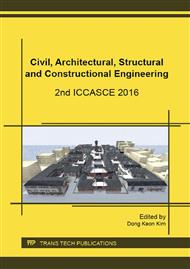[1]
H. Shi, K. F. Tee, Review of design and construction of hurricane protection barriers, Int. J. Forensic Eng. 2(2) (2014) 144-151.
Google Scholar
[2]
M. Safy, N. Moharamnejad, A. Danehkar, S. A. Jozi, Developing an appropriate mathematical model for the environmental risk assessment of jack-up drilling rigs (case study: South Pars field, Iran), Int. J. Environm. Sci. Technol. 12(10) (2015).
DOI: 10.1007/s13762-015-0786-1
Google Scholar
[3]
K. F. Tee, C. Q. Li, A numerical study of maintenance strategy for concrete structures in marine environment, Proc. of the 11th International Conference on Applications of Statistics and Probability in Civil Engineering, Zurich, Switzerland, 2011, August.
DOI: 10.1201/b11332-94
Google Scholar
[4]
K. F. Tee, L. R. Khan, H. P. Chen, A. M. Alani, Reliability based life cycle cost optimization for underground pipeline networks, Tunnel. Undergr. Space Technol. 43(7) (2014) 32-40.
DOI: 10.1016/j.tust.2014.04.007
Google Scholar
[5]
J. J. Wang, W. L. Dong, J. B. Li, L. S. Song, W. L. Chen, Feasibility analysis and application for cantilever beam extension of self-elevating drilling unit, Proceedings of the 25th International Ocean and Polar Engineering Conference, ISOPE 2015, Hawaii, USA, June.
Google Scholar
[6]
S. Zhang, P. T. Pedersen, H. Ocakli, Collisions damage assessment of ships and jack-up rigs, Ships Offshore Struct. 10(5) (2015) 470-478.
DOI: 10.1080/17445302.2014.1003173
Google Scholar
[7]
J. Zeng, G. Chen, H. T. Yuan, J. Mo, C. F. Li, C. Wang, The research on load test solution of cantilever system for POD- 5 jack-up, Proceedings of the International Conference on Ocean, Offshore Mechanics and Arctic Engineering -OMAE, San Francisco, California, USA, 2014, June.
Google Scholar
[8]
J. J. Jensen, A. E. Mansour, P. T. Pedersen, Reliability of Jack-up platform against overturning, Mar. Struct. 4(3) (1991) 203-229.
DOI: 10.1016/0951-8339(91)90002-s
Google Scholar
[9]
Y. Dalgic, I. Lazakis, O. Turan, S. Judah, Investigation of optimum jack-up vessel chartering strategy for offshore wind farm O&M activities, Ocean Eng. 95(1) (2015) 106-115.
DOI: 10.1016/j.oceaneng.2014.12.011
Google Scholar
[10]
C. Gaudin, M. J. Cassidy, B. Bienen, M. S. Hossain, Recent contributions of geotechnical centrifuge modelling to the understanding of jack-up spudcan behaviour, Ocean Eng. 38(7) (2015) 900-914.
DOI: 10.1016/j.oceaneng.2010.12.001
Google Scholar
[11]
G. J. Grundlehner, Systematic Model Tests on a Harsh Environment Jack-up in Elevated Condition, Mar. Struct. 10(2-4) (1997) 159-180.
DOI: 10.1016/s0951-8339(96)00022-6
Google Scholar
[12]
Y. G. Cao, S. H. Zhang, Failure analysis of a pinion of the jacking system of a jack-up platform, Eng. Fail. Anal. 33 (2013) 212-221.
DOI: 10.1016/j.engfailanal.2013.05.018
Google Scholar
[13]
P. Zhang, X. Yu, H. Ding, Spudcan bearing capacity calculation of the offshore jack-up drilling platform during the preloading process, Pet. Explor. Dev. 38(5) (2011) 613-619.
DOI: 10.1016/s1876-3804(11)60060-8
Google Scholar
[14]
Y. Jiao, S. L. Feng, H. Y. Liu, A quick method for the stability of jack-up platform towage. International Conference on Civil Engineering, Energy and Environment, Hong Kong, 2014, December.
Google Scholar
[15]
B. McCabe, B. Sheil, Pile Group Settlement Estimation: Suitability of Nonlinear Interaction Factors, Int. J. Geomech. 15(3) (2015) 10. 1061/(ASCE)GM. 1943-5622. 0000395, 04014056.
DOI: 10.1061/(asce)gm.1943-5622.0000395
Google Scholar


